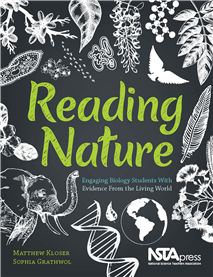Reading Nature: Evidence-Based Texts Inspire and Bring Context Into the Biology Classroom
By Carole Hayward
Posted on 2018-10-14
 Dedicated to “all those who wonder about the world around them,” Matthew Kloser and Sophia Grathwol’s new book Reading Nature: Engaging Biology Students With Evidence From the Living World uses quality research (from sources like the Journal of Animal Ecology and Nature) to give teachers a way to focus on core science ideas and get students to ask “why?” and “how do we know?”
Dedicated to “all those who wonder about the world around them,” Matthew Kloser and Sophia Grathwol’s new book Reading Nature: Engaging Biology Students With Evidence From the Living World uses quality research (from sources like the Journal of Animal Ecology and Nature) to give teachers a way to focus on core science ideas and get students to ask “why?” and “how do we know?”
This book comes at a good time for science teachers looking for source material they can trust. Even more helpful is the book’s beginning, which gives a thorough explanation of how to use the book, information on the impact the work will have on student outcomes, connections to standards, strategies, references, and more—everything an educator needs to successfully use this book with confidence.
Readers will find some familiar subjects in the book (Darwin’s finches show up in Text 10). But it’s not more of the same. The authors guide readers through the selection and give great discussion questions and supplementary materials; show how the selection can be used at different grade levels; point out which disciplinary core ideas, practices, and crosscutting concepts are addressed; suggest group tasks; and offer investigation design tasks.
This adaptable new book truly addresses the fact that we know more than ever about how students best learn and teachers best teach science. Memorizing facts is not enough; students need to be engaged and to understand how we know things just as well as they understand what they know.
Questions presented are just as easily applicable to students’ real life as they are to the evidence-based texts. For example, “What advantages do social groups provide to animals? Do red fire ants form cliques?” No doubt students will be engaged—as will teachers who pick up this smart new resource. What really sets this book apart is that people are central to all the texts (they highlight teams of people investigating the world) and that the investigations are placed in context.
Ready to explore and wonder? Let us show you the “evidence”! A free chapter is available: “Reading Nature: Engaging Biology Students With Evidence From the Living World.”
This book is also available as an ebook.
Follow NSTA
Disclaimer: The views expressed in this blog post are those of the author(s) and do not necessarily reflect the official position of the National Science Teaching Association (NSTA).

